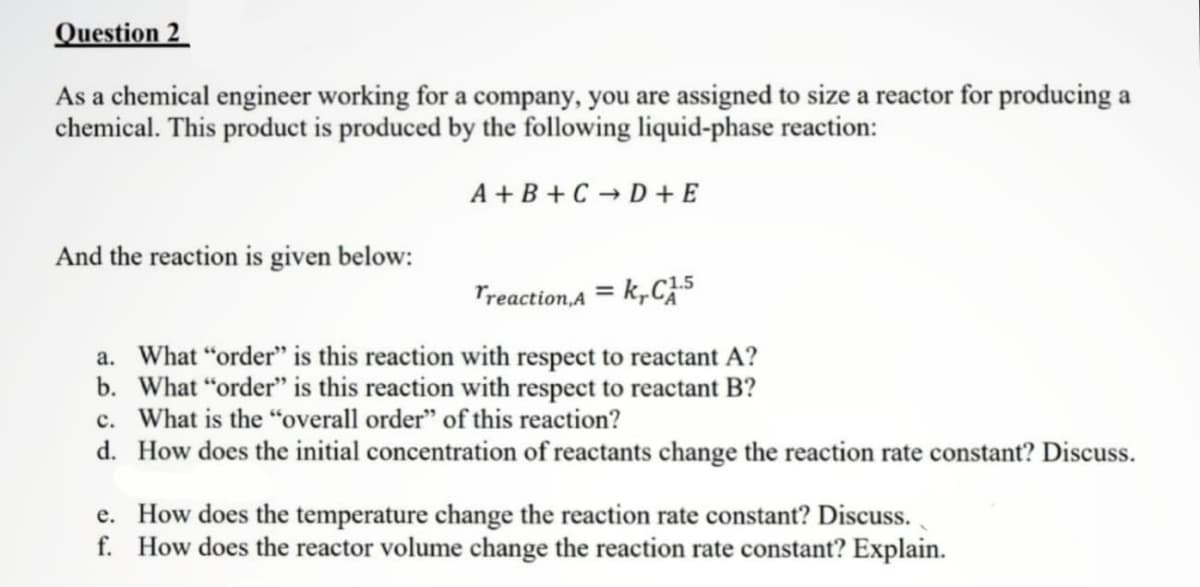As a chemical engineer working for a company, you are assigned to size a reactor for producing a chemical. This product is produced by the following liquid-phase reaction: A+B+CD+E And the reaction is given below: Treaction,A = k₁C1.5 a. What "order" is this reaction with respect to reactant A? b. What "order" is this reaction with respect to reactant B? c. What is the "overall order" of this reaction? d. How does the initial concentration of reactants change the reaction rate constant? Discuss. e. How does the temperature change the reaction rate constant? Discuss. f. How does the reactor volume change the reaction rate constant? Explain.
As a chemical engineer working for a company, you are assigned to size a reactor for producing a chemical. This product is produced by the following liquid-phase reaction: A+B+CD+E And the reaction is given below: Treaction,A = k₁C1.5 a. What "order" is this reaction with respect to reactant A? b. What "order" is this reaction with respect to reactant B? c. What is the "overall order" of this reaction? d. How does the initial concentration of reactants change the reaction rate constant? Discuss. e. How does the temperature change the reaction rate constant? Discuss. f. How does the reactor volume change the reaction rate constant? Explain.
Introduction to Chemical Engineering Thermodynamics
8th Edition
ISBN:9781259696527
Author:J.M. Smith Termodinamica en ingenieria quimica, Hendrick C Van Ness, Michael Abbott, Mark Swihart
Publisher:J.M. Smith Termodinamica en ingenieria quimica, Hendrick C Van Ness, Michael Abbott, Mark Swihart
Chapter1: Introduction
Section: Chapter Questions
Problem 1.1P
Related questions
Question

Transcribed Image Text:Question 2
As a chemical engineer working for a company, you are assigned to size a reactor for producing a
chemical. This product is produced by the following liquid-phase reaction:
A+B+CD+E
And the reaction is given below:
Treaction,Ak,C1.5
a. What "order" is this reaction with respect to reactant A?
b. What "order" is this reaction with respect to reactant B?
c. What is the "overall order" of this reaction?
d.
How does the initial concentration of reactants change the reaction rate constant? Discuss.
e. How does the temperature change the reaction rate constant? Discuss.
f. How does the reactor volume change the reaction rate constant? Explain.
Expert Solution
This question has been solved!
Explore an expertly crafted, step-by-step solution for a thorough understanding of key concepts.
Step by step
Solved in 3 steps with 3 images

Recommended textbooks for you

Introduction to Chemical Engineering Thermodynami…
Chemical Engineering
ISBN:
9781259696527
Author:
J.M. Smith Termodinamica en ingenieria quimica, Hendrick C Van Ness, Michael Abbott, Mark Swihart
Publisher:
McGraw-Hill Education

Elementary Principles of Chemical Processes, Bind…
Chemical Engineering
ISBN:
9781118431221
Author:
Richard M. Felder, Ronald W. Rousseau, Lisa G. Bullard
Publisher:
WILEY

Elements of Chemical Reaction Engineering (5th Ed…
Chemical Engineering
ISBN:
9780133887518
Author:
H. Scott Fogler
Publisher:
Prentice Hall

Introduction to Chemical Engineering Thermodynami…
Chemical Engineering
ISBN:
9781259696527
Author:
J.M. Smith Termodinamica en ingenieria quimica, Hendrick C Van Ness, Michael Abbott, Mark Swihart
Publisher:
McGraw-Hill Education

Elementary Principles of Chemical Processes, Bind…
Chemical Engineering
ISBN:
9781118431221
Author:
Richard M. Felder, Ronald W. Rousseau, Lisa G. Bullard
Publisher:
WILEY

Elements of Chemical Reaction Engineering (5th Ed…
Chemical Engineering
ISBN:
9780133887518
Author:
H. Scott Fogler
Publisher:
Prentice Hall


Industrial Plastics: Theory and Applications
Chemical Engineering
ISBN:
9781285061238
Author:
Lokensgard, Erik
Publisher:
Delmar Cengage Learning

Unit Operations of Chemical Engineering
Chemical Engineering
ISBN:
9780072848236
Author:
Warren McCabe, Julian C. Smith, Peter Harriott
Publisher:
McGraw-Hill Companies, The